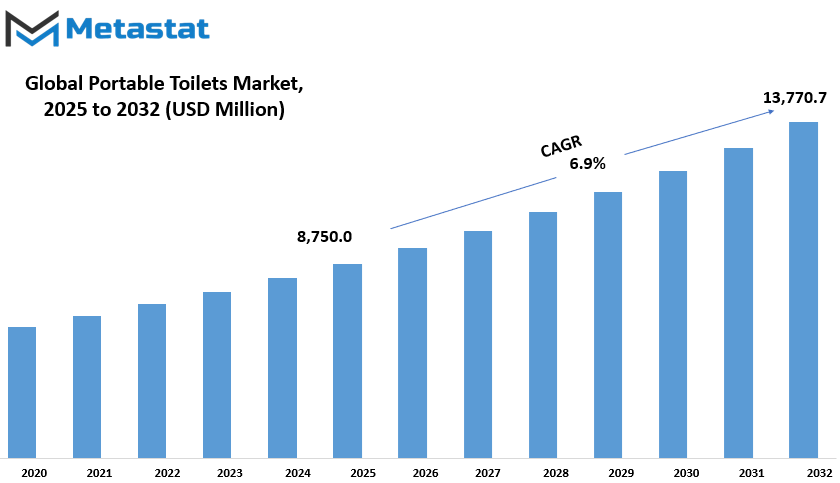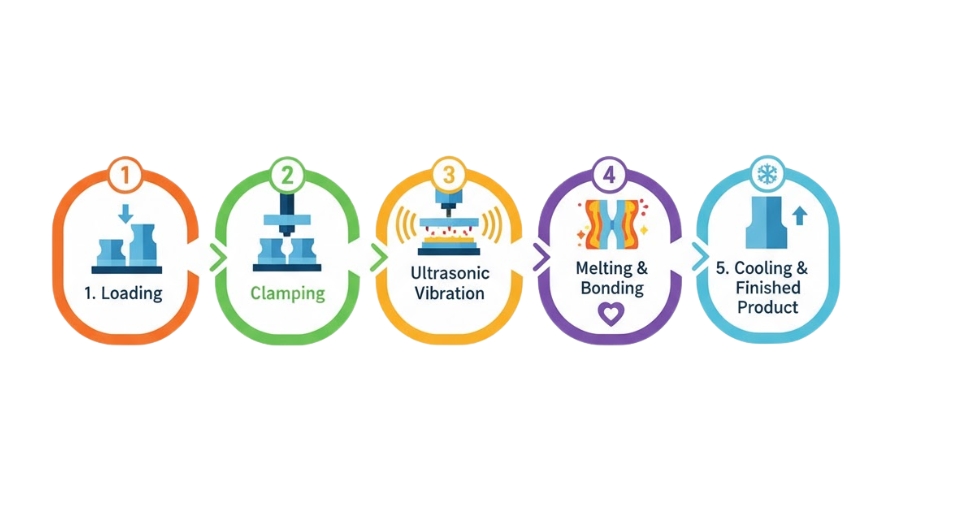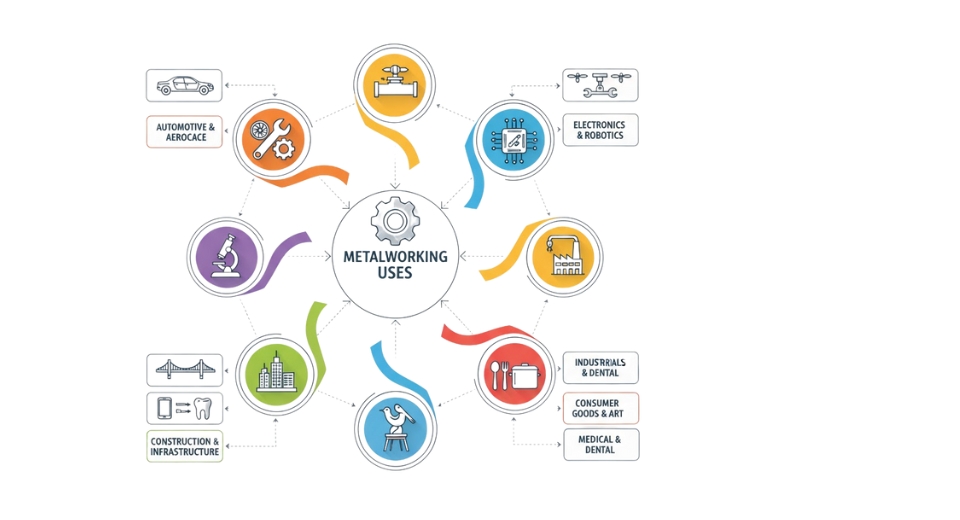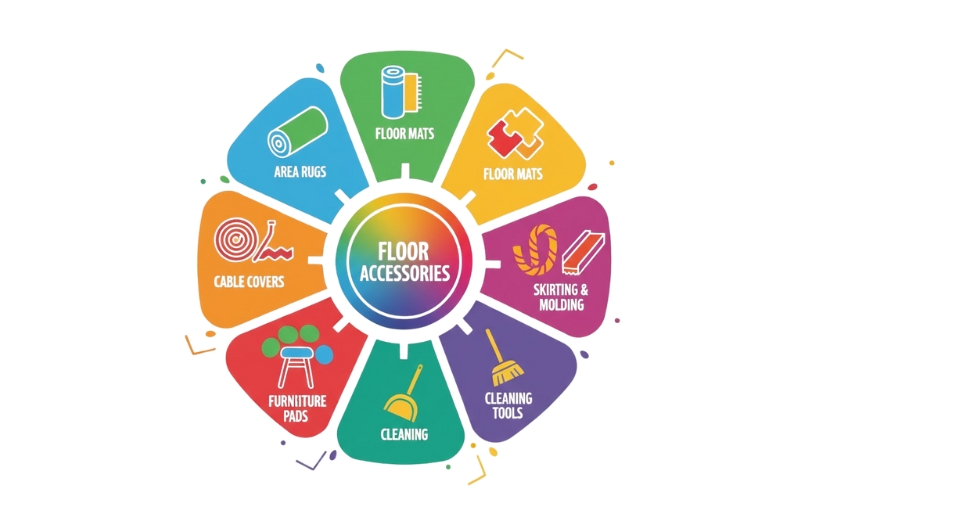MARKET OVERVIEW
The Global Portable Toilets market serves specifically to answer the demand for temporary and mobile solutions. Here, within unfeasible situations for traditional facilities, the market shall forever be driven by demands for efficient waste management. In keeping up with such booming industries as construction, outdoor events, disaster reliefs, and tourism, demand for portable sanitation solutions will automatically grow; hence this market becomes an integrative part of the whole endeavor geared towards maintaining hygiene standards in different sectors.
In the future again, the Global Portable Toilets market is most probably going to be altered in all respects so that better performance under environmental concerns can be achieved. Sustainable matters will more and more draw attention to eco-friendly materials and waste disposal. Manufacturers will then focus on creations that are less damaging to the environment, either through biodegradable material or cutting-edge technology in waste treatment. Such innovations will thus appeal to environmentally aware consumers while at the same time satisfying the increased regulatory pressures from governments worldwide, demanding ever more sustainable practices in waste management.
Moreover, growth in the Global Portable Toilets market will increase when companies finally start to feel the necessity of providing proper sanitary facilities for their employees in remote areas. Construction and mining are industries where the personnel are going to spend considerable amounts of time away from any urban setup, and availability of portable toilets will become a big factor for the comfort and productivity of such workers. With increasing focus on employee welfare, companies will soon be expected to provide such facilities, thereby further fuelling the growth of this market.
Technological advancements will also contribute a lot to the future growth of the Global Portable Toilets market. Innovations related to design and functionality will lead to the development of user-friendly and efficient products. The new models are going to attract the market with features for odor control, better ventilation, and easy cleaning processes. This will appeal not just to the high-end market, where luxury and convenience are at stake, but also to the wider market, where practicalities and price come into play.
The Global Portable Toilets market is further going to grow beyond such smidgens of geography which presently have poor or no sanitation infrastructure. When these regions realize the perceived benefits of the utility, they will be turning out as major consumers of portable toilets in the near future. Sanitation concerns in places afflicted by natural calamities or humanitarian crises will see real investments in portable toilets by international aid organizations and governments, giving this market an added fillip.
Global Portable Toilets market is estimated to reach $13,770.7 Million by 2032; growing at a CAGR of 6.9% from 2025 to 2032.

GROWTH FACTORS
The global portable toilets market is growing at a very high rate, and, thus influenced by the major factors that will influence its future. Construction activities being on the rise and that outdoor events complementally match the increase in portable toilet demand. The demand for the sanitary solution in circumstances where conventional facilities are impractical or inaccessible is catered to by the growth.
One issue that has come to the forefront in recent times is the standards of sanitation and hygiene. With even more emphasis on cleanliness, adoption of portable toilets has multiplied. These units provide intermediate-level solutions in hygiene where permanent restroom facilities would be limited and, hence, encourage better health and sanitation.
But there are still some challenges. One critical aspect is raw materials due to the affecting costs and availability of portable toilets. The prices for raw materials for making the units may be extremely erratic, and maintaining a standard price point may pose considerable difficulties for manufacturers affecting the overall market. Second, the waste disposal infrastructure itself is otherwise varying from one region to another; in the areas where this infrastructure is thin or hardly developed, so naturally that will act as a major limiting factor towards the growth of the portable toilets market.
But the outlook is bright against all odds. Increasing sustainability and eco-friendly solutions constitute one of the big themes in the portable toilets market. Heightened environmental consciousness demands toilets built with eco-friendly materials and technologies. This change toward sustainable consideration translates into an opportunity for the market players to innovate and feed the advancing consumer behaviour and regulations.
Thus, in the global view of the portable toilets, the years to come will prove to be of greater growth in the market. Demand will continue to be driven by steady growth in construction and outdoor activities. Also, advancements in the waste management technology and the increased focus on sustainability will be expected to open up new avenues for growth. Companies able to play to these challenges and exploit the emerging trends stand to put themselves in a very good position in an evolving portable sanitation marketplace.
MARKET SEGMENTATION
By Type
The Global Portable Toilets market has undergone fast transformation phase owing to a change both in the needs of consumers and in the technological change. This indicates that it would grow and transform itself largely if looked forward into the future. To find an ideal growth in the number of factors, demand for toilets and sanitation solutions is in itself among developing both developed and developing regions.
In the future product type will be featured more specialized. For example, the portable toilets will further develop from portable restroom to portable toilets. Generally portable toilets are relatively primitive and smaller in size. They are usually made for easy use and maintenance and, hence represent one of the mainstays of temporary placements associated with outdoor events, construction sites, and rural areas. These units are substantially lower cost for satisfying sanitation needs and are almost always preferred when simplicity and cost are two important considerations in a decision.
Portable toilets, on the other hand, are on a comparatively more advanced level. They are usually designed to provide a comfort level and convenience; sophistication especially is made to suit long-term uses and high-profile events. Most of them are equipped with a flushing system, standard requirements such as handwashing stations, and a much roomier interior. They are made for occasions when "more" is desired for larger events, corporate functions, and even emergency response situations.
Indeed, this distinction might become even sharper as the market progresses. Improvement in both types will be brought about by innovations in materials and designs as they address the growing hygiene, convenience, and environmental sustainability needs. For example, it is quite certain that future portable toilets will be cleaner and require less water, boasting better means for waste handling and management. Some top-end amenities, together with increased user comfort, will serve to further lure portable restrooms to elite events and long-term installations.
The ever-increasing worldwide portable toilet industry predicts increased competition in all these categories of products. This will force companies into change, designing new tastes of consumers and technology within the market. It can lead to an increase in different types of products and services to meet various needs and applications.
By Product
The portable toilets market has recently seen some paradigm shifts in its structural design to cope with future demands. Urbanization and frequent outdoor events drive the demand for portable sanitation solutions. Generally, they fall into two main categories: standard portable toilet and luxury toilet.
Standard portable toilets usually provide basic sanitation services and are most common at construction sites, public events, and temporary setups requiring sanitation. This basic toilet consists of a toilet seat, holding tank, and often hand sanitizer; otherwise, it is quite simple and functional. Being affordable and practical at the same time makes them very much in demand in several situations.
Luxury portable toilets, however, are the opposite end of the spectrum with all the features and comfort to satisfy the higher clientele. They might feature running water, flushing toilets, even climate control, making them ideal for high-end events or just occasions where comfort counts that much, such as more elegant outdoor weddings. The luxury segment is where consumer expectations have been the most changed, where function is no longer the essence of a product but now something that will also add to pleasure and comfort.
Looking into the future, portable toilets are expected to evolve to meet market demands. With more outdoor activities and temporary events being organized, there is an increased demand for portable toilets, both standard and luxury. The standard ones will be very necessary because they are practical and cheap to acquire, while luxurious models will be for that special niche that desires better experiences.
In general, the future of the global portable toilets market holds great potential for further growth and transformation. Consumer trends and the introduction of new technologies will decidedly affect the standard-versus-luxury balance. Consequently, trends must remain on the radar of those in the know in order to serve their clients and prosper in this ever-changing marketplace.
By Technology
The future innovations in the Global Portable Toilet sector in the coming years will be greatly realized in these technological implementations that curtail the sector. The existing segmentation based on the technology for portable toilets can be classified into vacuum-based, gravity-based, and other systems. Each of these technologies has a future that is unique to itself, hence representing a different way of imparting the impact.
Among all those technologies mentioned above, vacuum-based technologies stand to be the most efficient and eco-friendly. This system works on the principle of suctioning waste, thereby eliminating the use of a lot of water like the older systems. In today's concern of water shortage, the vacuum system will surely gain prominence. Hence, future innovations will revolve around energy efficiency, compactness, and ease of use. This has special relevance where a portable solution is required in resource-limited areas.
Gravity-dependent systems are all about simplicity and reliability, as such systems depend solely on the force of gravity to move the waste. Maintaining and operating those systems are carried out at ease, hence making them more embraced. Looking into the future, the technologies surely need to be improved with a better material that will guarantee this type of system will become lighter and durable. In the meanwhile, design advancements would also enhance the versatility of these systems in relation to different waste types and situations.
Other possible technologies include several kinds of state-of-the-art technologies that cannot be associated with either the vacuum or gravity-based classification. It also includes composting toilets and systems using chemical treatments. This may only expand with market diversification and discussion on new solutions catering to specific needs. Composting toilets, systems that incorporate the use of composting for the disposal of toilet waste, are attracting attention as they have a very low environmental impact. Such systems enter the realm of possibility as new technologies will tend toward increased efficiency, ease of use, and attraction to wider use.
Most probably, these developments in technology will cause some notable major changes in the Global Portable Toilets market in the future. With each technology, the market evolves according to changing demand and preference for that time. This implies that innovations are expected to overcome not only functionality but also environmental and logistic problems. Monitoring these trends provides a good change to predict what to expect in the future, and thus timely and relevant investment and developmental decisions could be taken by the very fact.
By Application Thus making it a very bright future of the Global Portable Toilets market and leading it further heights. This market will mainly be supported by changing needs and technological advancement into time. Therefore, the various applications of portable toilets are, accordingly, some among the countless motives that will affect their future progress.
Portable toilets have a very good future at construction sites. With every construction project becoming bigger and bigger, the pressure on site will only increase for an effective and hygienic toilet system. Meanwhile, over the years, portable toilets will undergo innovative design changes that will make them meet the needs of workers even better, such as more durability and easier maintenance.
Recreational vehicles, such as trucks and vans, form another point of growth. The portable toilet will be greatly welcomed when it finds itself installed inside a recreational vehicle as more people adapt to a traveling lifestyle and outdoor adventure. Most innovations in this area will revolve around the design of a portable toilet that is compact and fits into as many vehicle types as possible to provide comfort and practicality for the traveler.
This will also see an increase in portable toilets applied in public places. In relation to the increase in population and outdoor activities, there will also be a demand for efficient sanitation solutions in the city environment, parks, and other public places. Future developments in this area could focus on improvements in the cleaning features and users' experience or high-traffic environments design.
Emergency situations come to mind in the healthcare sector or the establishment of temporary healthcare facilities; design will have to take a drastic turn over here, focusing on hygiene and ease of use by both patients and healthcare providers. Expected Mobilized sanitation features and mobility ease may lead to innovations in this application.
Camping and events are other major applications for porta toilets. As people spend more free time outdoors, the market for portable sanitation solutions will expand significantly to meet the challenge of providing a good standard of reliable comfort. Models for the future could be designed with extra features in mind that would enhance their suitability to outdoor conditions or make them more easily portable and deployable.
Marine environments are also expected to continue driving demand for the Global Portable Toilets market further. Portable toilets for boats and other marine facilities, in this regard, need to be specifically designed to counter difficulties such as exposure to water and very limited space. The Global Portable Toilets market is fast-tracked into huge success through different types of needs across a very broad application base.
|
Forecast Period |
2025-2032 |
|
Market Size in 2025 |
$8,750.0 million |
|
Market Size by 2032 |
$13,770.7 Million |
|
Growth Rate from 2025 to 2032 |
6.9% |
|
Base Year |
2025 |
|
Regions Covered |
North America, Europe, Asia-Pacific, South America, Middle East & Africa |
REGIONAL ANALYSIS
Long-term prospects-Regional disparities in the portable toilets market worldwide would be another major driving factor influenced by various requirements and development in various regions. In North America, the region comprising the United States, Canada, and Mexico would retain its vigor, thanks to the high demand originating from events, construction activities, and outdoor activities. High-end infrastructure and a robust economy so characterize these countries that their portable sanitation solutions will continue to enjoy stable demand. In the U.S., one such market, it is also going to be huge due to megasize events and constant construction works that will drive the portable toilet rental market.
Environmental sustainability and hygiene standards have become a big focus in Europe, including the United Kingdom, Germany, France, Italy, and so on, and this will only further spur development for the portable toilet market. Improved portable toilet technology will surely be shaped and honed in these countries by the tight regulations and focus on 'green' solutions typical of most European countries. There is wide diversity in need-from large-scale public events down to custom services for local smaller festivals-in Europe to drive innovation and customization in portable sanitation solutions.
Such great speed in the development of the portable toilets market is expected to actually happen in the countries like India, China, Japan, and South Korea, and the rest of Asia, as the spatial context gets filled by urbanization and population increase furthered by social awareness on sanitation. The demand for portable solutions in terms of temporary and outdoor situations will also rise with more people in developing countries who can afford improved sanitation facilities. Whoever said that the demands put on this area will be wide and varied, requiring very different portable toilet designs that can only be adapted to these specifications?
Market demand will also see a consistent growth trend in Brazil and Argentina, among other countries in the region. The growing focus on creating reliable infrastructure and enhancing public health should support the rise of this sector. Major events and construction activities in big cities will both fuel portable toilets' demand and create opportunities for growth in urban and rural areas.
Because of climate, economic development, and infrastructure works, the Middle East & Africa market is expected to witness burgeoning demand. The region is further sub-segmented into GCC countries, Egypt, South Africa, and the rest of Middle East & Africa. Due to climatic extremes, demand for heavy-duty, high-quality portable toilets will soar in the Middle East. In Africa, we shall focus on expanding access to sanitation in urban and inaccessible areas.
Basically, the global portable toilets market shall remain rather dynamic across these regions, each driven by local needs, economic conditions, and environmental concerns.

COMPETITIVE PLAYERS
In the global portable toilets market, the trend is cemented by rising convenience and hygiene demands across a variety of setups. This is aided by outdoor parties, construction sites, and responses to natural calamities when permanent restroom facilities are nowhere near. Some of the key players in this segment include Ace Portable Toilets, The TOI TOI & DIXI Group GmbH, Armal Srl, B&B Portable Toilets, and Biffs, Inc. Among the more appealing innovations they are pursuing are customization to meet such diverse client expectations.
For example: The Ace Portable Toilets company has portable toilets suitable for any occasion, be it large or small. Their standards for comfort and function are setting new standards within the industry. Having been around for a long time and dealing abroad, TOI TOI & DIXI Group GmbH initiated the market with stable and user-friendly products. Contributing to the market through their philosophy of quality and customer satisfaction, Armal Srl and B&B Portable Toilets also played a role.
Technological advancement, along with changing consumer behavior, will be another reaffirming factor for the development of the global portable toilets market in the future. There are Biffs, Inc. and Blue Bowl Sanitation Inc., both in the process of monitoring advanced sanitation systems and increasing comfort for users. These echo a new trend in both functionality and aesthetics for portable restrooms.
Another key company in this market, Camco Manufacturing Inc., and Elsan Limited are ardently inventing green and efficient portable toilets, where such kind of movement towards sustainability will be a major concern in the upcoming years for the industry, where many other companies, including Formit Services Pty Ltd and Halco Portables, might find their focus moving toward greener methods and technologies around.
Other drivers besides technology would include regionalism and economic constants as a part of the global portable toilets market. Handi-Can Portable Toilets and NuConcepts are two companies looking to increase their footprint in various regions by meeting certain regional requirements and tastes and preferences. Similarly, PolyJohn Enterprises and PolyPortables are also taking steps to tailor their product offerings according to differing marketplace demands.
That's equally being driven by the increasing number of outdoor events and construction activities requiring temporary restroom facilities. This is an opportunity for companies with reliable and versatile products such as Sanitation Equipment Ltd and Sanitech. Satellite Industries and Shorelink International Ltd are also among those contributing to the growth of the industry with their dozens of innovations.
Portable Toilets Market Key Segments:
By Type
- Portable Toilet
- Portable Restrooms
By Product
- Standard
- Luxury
By Technology
- Vacuum Based
- Gravity Based
- Others
By Application
- Construction Sites
- Recreational Vehicles (Trucks, Vans, etc.)
- Public Places
- Healthcare
- Outdoor Activities (Camping, Events, etc.)
- Others (Marine, etc.)
Key Global Portable Toilets Industry Players
- Ace Portable Toilets
- TOI TOI & DIXI Group GmbH
- Armal Srl
- B&B Portable Toilets
- Biffs, Inc.
- Blue Bowl Sanitation Inc.
- Camco Manufacturing, Inc.
- Elsan Limited
- Formit Services Pty Ltd
- Halco Portables
- Handi-Can Portable Toilets
- NuConcepts
- PolyJohn Enterprises
- PolyPortables
- Sanitation Equipment Ltd
WHAT REPORT PROVIDES
- Full in-depth analysis of the parent Industry
- Important changes in market and its dynamics
- Segmentation details of the market
- Former, on-going, and projected market analysis in terms of volume and value
- Assessment of niche industry developments
- Market share analysis
- Key strategies of major players
- Emerging segments and regional growth potential








 US: +1 3023308252
US: +1 3023308252






